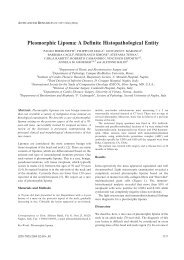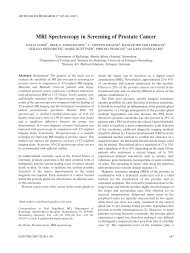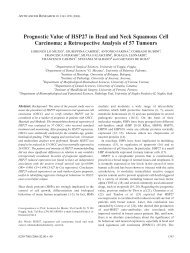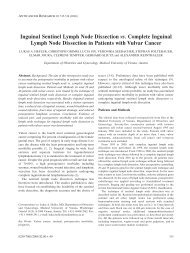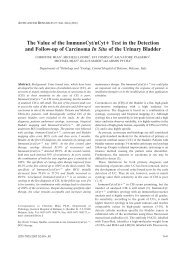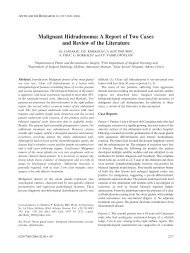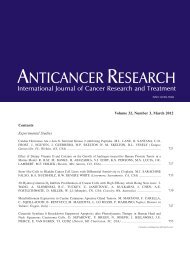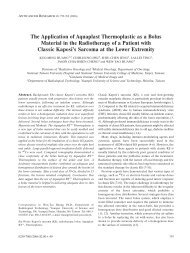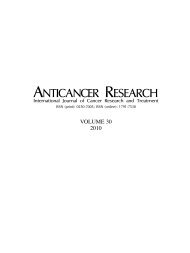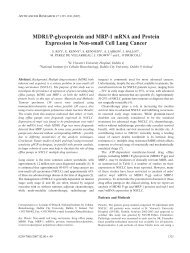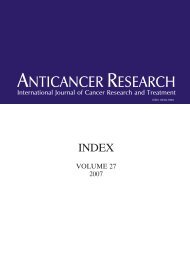ABSTRACTS OF THE 21st ANNUAL MEETING OF THE ITALIAN ...
ABSTRACTS OF THE 21st ANNUAL MEETING OF THE ITALIAN ...
ABSTRACTS OF THE 21st ANNUAL MEETING OF THE ITALIAN ...
You also want an ePaper? Increase the reach of your titles
YUMPU automatically turns print PDFs into web optimized ePapers that Google loves.
Background: Recent analyses suggest that the fractionation<br />
sensitivity of prostate tumors is high and many<br />
hypofractionated protocols are being tested (1). Since the<br />
alpha/beta ratio estimates for prostate cancer are much lower<br />
than the typical values for many other types of tumor (2), we<br />
performed a small randomized trial to compare a<br />
hypofractionated versus a conventional schedule for<br />
radiotherapy in localized prostate carcinoma. We have already<br />
reported the acute toxicity (3). Now our aim is to evaluate late<br />
gastrointestinal (GI) and genitourinary (GU) toxicities in the<br />
two patient groups and to assess the mathematical model<br />
theoretically predicting equivalent fractionations. Patients and<br />
Methods: From September 2008 to July 2009, 40 patients with<br />
cT1-T2N0M0 prostate cancer were randomized to receive<br />
either a conventional or a hypofractionated radiation therapy<br />
with curative intent. Patients were stratified according to stage,<br />
Gleason score and presenting prostate-specific antigen level;<br />
9 patients were at low risk and 31 patients were at<br />
intermediate risk according to Partin classification. The latter<br />
patient group received neoadjuvant hormonal therapy that<br />
started two months before the radiotherapy onset and<br />
continued during radiotherapy. Treatments were delivered<br />
using four to six coplanar 10-18 MV photon beams at a dose<br />
of 72- 78 Gy in 36-39 fractions within 7-8 weeks, or 64.8-70.2<br />
Gy in 24-26 fractions within 5 weeks. Based on standard<br />
linear-quadratic modeling, the hypofractionated protocol was<br />
designed to keep late complications constant in rectal tissues.<br />
GI and GU toxicities were scored according to the<br />
RTOG/EORTC system. Efficacy of radiotherapy, based on<br />
clinical, radiologic and prostate-specific antigen data, was also<br />
evaluated every three months for two years and every six<br />
months subsequently. Results: All patients completed the<br />
whole course of radiotherapy without interruptions. Minimum<br />
follow-up was one and a half years; median follow-up was 25<br />
months. None of the patients experienced grade 3-4 toxicity.<br />
Grade 1 and grade 2 GI and GU toxicities occurred during and<br />
soon after treatment in both groups without significant<br />
differences. In the long term, 35% of patients in the<br />
hypofractionated group and 40% of patients in the control<br />
group reported increased frequency of urination or nocturia<br />
(p>0.5). Their symptoms cannot be scored as G1 because they<br />
did not reach twice the level of the pretreatment habit. Only<br />
one patient in the hypofractionated group presented an actinic<br />
proctitis (p>0.5); moreover, this patient suffered from a preexisting<br />
hemorrhoidal disease. Discussion and Conclusion: No<br />
difference was noted in the chronic complications between<br />
hypofractionated and conventionally fractionated radiotherapy<br />
groups. As regards late rectal side-effects, according to the<br />
linear-quadratic formula in our study design, late toxicity was<br />
already expected to be equivalent in the two treatment groups.<br />
Our study confirms that hypofractionation is a promising<br />
regimen for prostate cancer radiotherapy and that a linearquadratic<br />
formula is a reliable radiobiological model. The<br />
1888<br />
ANTICANCER RESEARCH 31: 1807-1956 (2011)<br />
follow-up period was long enough to conclude that the<br />
hypofractionated schedule was well tolerated in both the short<br />
and long term and the incidence of clinically significant GI<br />
and GU toxicity after conventional and hypofractionated<br />
radiotherapy appeared to be similar. Longer follow-up is<br />
mandatory to evaluate the effectiveness of the two regimens.<br />
Regarding tumor control, assuming a low alpha/beta ratio for<br />
prostate carcinoma, we expect an interesting therapeutic gain.<br />
1 Brenner DJ et al: Direct evidence that prostate tumors show<br />
high sensitivity to fractionation (low α/β ratio), similar to<br />
late-responding normal tissue. Int J Radiat Oncol Biol Phys<br />
52: 6-13, 2002.<br />
2 Dasu A: Is the α/β value for prostate tumors low enough to<br />
be safely used in clinical trials? Clinical Oncol 19: 289-301,<br />
2007.<br />
3 Spagnoletti G et al: Hypofractionated versus conventionally<br />
fractionated radiation therapy for prostate cancer: our first<br />
results. Anticancer Res 30: 1472-1473, 2010.<br />
148<br />
VIRTUAL HDR CYBERKNIFE ® TREATMENT FOR<br />
LOCALIZED PROSTATE CANCER. PRELIMINARY<br />
EXPERIENCE<br />
Antonio Pontoriero1 , Donatella Arpa1 , Carmelo Siragusa2 ,<br />
Federica Midili2 , Isidora Ielo2 , Giuseppina Anastasi3 ,<br />
Carlo Magno3 and Costantino De Renzis1 1A.O.U. Policlinico "G. Martino" Università degli Studi di<br />
Messina, U.O.C. di Radioterapia, Messina, Italy;<br />
2U.O.C. Fisica Sanitaria and 3U.O.C. Urologia, A.O.U.<br />
Policlinico "G. Martino" Messina, Messina, Italy<br />
Aim: The Cyberknife is an imaging-guided device for<br />
delivering high radiation doses to a precisely defined threedimensional<br />
target volume. The Virtual HDR Cyberknife is<br />
indicated for patients with localized cancer prostate (T1-T2b)<br />
with favorable prognosis (Gleason score ≤6, PSA ≤10 ng/ml)<br />
and selected patients with intermediate prognosis (Gleason<br />
score of 7, PSA 10.2-20 ng/ml). The low α/ß ratio for prostate<br />
cancer requires high radiation with an hypofractionated<br />
schedule of dose for tumor control and it has been shown to be<br />
biologically lethal for prostate cancer cells. In this report, we<br />
summarize preliminary experience with planning emulating<br />
HDR brachytherapy dose distribution. Patients and Methods:<br />
At our institution, over a period of 36 months, 11 patients with<br />
a median age of 78 (range 73-86) years and a median Gleason<br />
score of 6 (range 5-7) were submitted to treatment with the<br />
Virtual HDR Cyberknife. The planning target volume (PTV),<br />
defined with MRI and CT imaging, included the prostate and<br />
seminal vesicles, plus 2 mm of expansion for favorable<br />
prognosis or 5 mm for intermediate prognosis in all directions,



